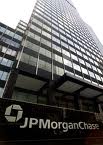JPMorgan Chase Blows Away Analysts’ Estimates, Lies Beyond Expectations
Last Thursday, I woke up extra early to hear Jamie Dimon of JPMorgan Chase lie through his teeth about his mega-bank’s quarterly earnings. Analysts were expecting a lie of around 70 cents a share, but Mr. Dimon exceeded all expectations for lying, reporting earnings of $1.09 a share. Now, to be fair, some of that was made up of one-time items, and some of it was just plain made up. But even so, taking away the one-time events, JPMorgan Chase would have reported earnings of 87 cents a share. Fabulous, isn’t he? And handsome too.
To be entirely honest about the whole thing, it made me queasy for half an hour or so, and I had to get up and walk around. I didn’t need a part time job last week, I had more than enough on my plate as it was. And here was Dimon telling me I would soon have to spend a good six hours trying to figure out how to separate the wheat from the bank’s chaff.
I know what you’re thinking… “Oh, goodie… an accounting article… I just love these.” Yeah, well don’t worry, their not exactly my favorite kind to write either, but this one’s important.
JPMorgan Chase’s earnings report was all sunshine and flowers, the bank reported a drop in net revenue of 8%, which was in line with what Wall Street was expecting. But the bank’s investment banking and fixed income securities trading, both fell in Q2, as compared with Q1. So, where did all that money come from that allowed JPMorgan Chase to report such astonishing quarterly results?
It’s really quite simple… Dimon took $1.5 billion out of the bank’s account that’s labeled “reserves for future losses,” which is obviously supposed to be there in anticipation of future losses on bad loans, and called it “profits,” by taking it to the bottom line. Nice, huh? Losses… hmmm… now why on earth would anyone worry about losses at JPMorgan Chase at a time like this?
Actually, the whole thing was confusing because Dimon also cautioned analysts that the bank’s “losses from bad loans remain elevated.”
But, I suppose as long as Geithner doesn’t make the mega-bank write down any losses in the future, everything will work out just fine and dandy. What, me worry? No chance of that. Besides, I don’t know why anyone would have a hard time believing anything a bank said these days. I mean, these guys wouldn’t lie, right? Flourish the thought.
I’m not the only one that was skeptical about JP’s earnings. MoneyWeek’s David Stevenson also found the numbers hard to believe. You can see his analysis in his article: US banking recovery is a sham.
Mike “Mish” Shedlock didn’t buy it either. He points out that JPMorgan Chase’s earnings hese have now climbed right back to 2007’s high point, which he describes as being “nothing short of amazing.” He also points out that “it’s more than enough to get bank bulls quite excited again.”
Mish also explains JPMorgan Chase’s figures “aren’t as good as they first seem”. He explains:
“… the bank only turned in such a ‘good’ result because it slashed its “provision for credit losses” by two thirds, from $9.7bn to $3.4bn. In other words, all (and more) of JP Morgan’s latest profit was due to the bank making a much lower allowance for bad debts – loans that could go sour because the debtors can’t repay to the bank the money they’ve borrowed.”
Of course, that’s not all the bank has going for it in fantasy earnings land. Compliance with various accounting rules has been a thing of the past as far as our banks are concerned for some time now, and perhaps long enough for investors to have forgotten. Commercial real estate values have fallen by more than 40 percent, but Geithner and Bair are still not requiring the assets to be written down to market value, and FASB 157 still allows certain residential mortgages the same sort of treatment, so the actual value of a good portion of any bank’s assets is at least questionable in my mind.
Mish also explained another aspect of how FASB 157 is artificially inflating earnings related to how banks value and account for bonds sold by banks, and this one I did not know. Apparently, FASB 157 allows banks to “pretend” they’ll be buying back bonds they issued at current market rates, regardless of their true intentions. If the market value of the bank’s bonds falls, banks are now permitted to assume that they owe less to their creditors, booking the difference between the previous market price and the new lower price as a profit, even though such changes in the value of the bonds don’t affect how much the bank actually owes.
Mish, along with others that cover the banking industry, say to expect more of this sort of accounting witchcraft, with Bank of America, Morgan Stanley and Citibank all expected to take billions to their bottom lines as a result of what FASB 157 now allows.
Lastly, Housing Wire reported just yesterday that JPMorgan Chase’s REO (Real Estate Owned) assets, at least those insured by government agencies… have come close to tripling in value on their balance sheet since the second quarter of 2009, mostly because the bank had to buyback mortgage backed securities from Ginnie Mae. No further details as to why were offered by Dimon or Chase, but I think its safe to assume that most of what was bought back, was at least 60 days delinquent, and quite possibly longer.
I don’t know if its occurred to anyone else at this point, but none of this sounds like “banking.” Does it to you? All I see are accounting tricks and some bad federal policy. And in response to that sort of thing, it looked to me as if the market was just about ready to kiss Dimon’s ring, as he reported the good news last Thursday.
Well, as you might imagine, I am nowhere near ready to do any ring kissing. Dimon and his bankster pals are all expected to continue this emergent accounting slight of hand for a while … anything to keep the optics up and Wall Street feeling groovy.
I wish Jamie cared about his bank’s optics related to HAMP loan modifications. According to Treasury’s latest HAMP report, JPMorgan Chase has offered 880,000 loan modifications to homeowners, with roughly 245,000 having been approved… but, wait… get this… the banks says that just over 54,000 permanent HAMP modifications have been granted through the end of June. 54,000 vs. 880,000?
I just don’t understand it… how can they be so adept at accounting, and yet, when it comes to a modifying a loan, they lose paperwork, struggle to calculate income properly, data enter the wrong numbers, and find it impossible to explain to anyone why they’ve failed an NPV test?
Never mind… I don’t know why I even bother asking such questions anymore.
And all this is after Dimon essentially was given WaMu for $1.9 billion. Branches totaling 5400 in California, Washington and Florida, among other states, a sizable credit card operation, about $900 billion in deposits, the most of any U.S. bank, and roughly $90 billion in mortgages, and $60 billion give or take in servicing rights, if memory serves. All that for $1.9 billion? That’s less than two billion dollars for the whole package. Oh, and Bear Stearns wasn’t exactly over priced either.  It’s impossible to tell from looking at the bank’s financials, but it seems to me that Jamie would have to have written some of these assets up, as opposed to down.
All I can say is this… our banking system is no longer a banking system… the toxic assets are right where they were in October of 2008… none make loans… none follows accounting rules…  in fact, almost 100 percent of all of the major banks earnings last year came from their trading desks.  And this year it looks like they’re pulling them out of their…
Mandelman out.







